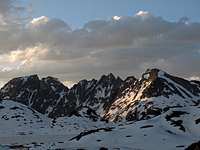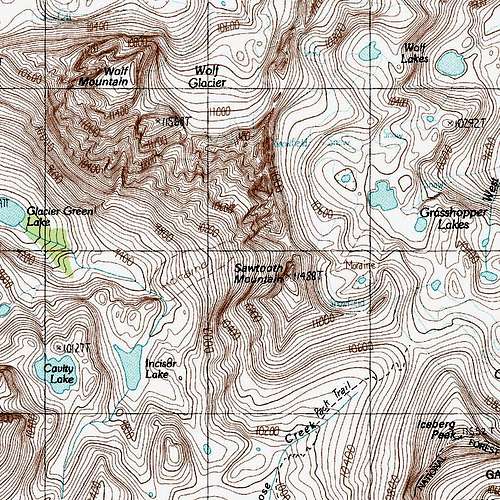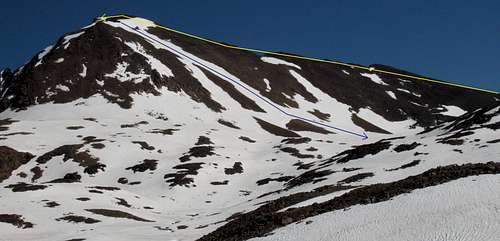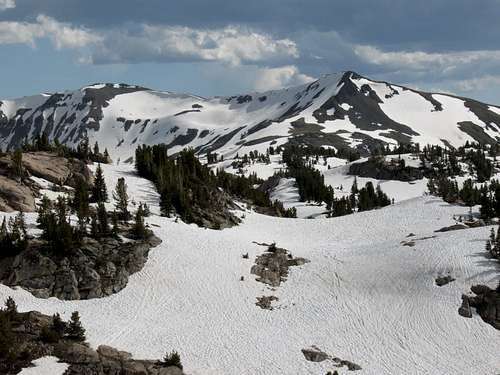-
 16082 Hits
16082 Hits
-
 86.85% Score
86.85% Score
-
 23 Votes
23 Votes
|
|
Mountain/Rock |
|---|---|
|
|
45.13961°N / 109.90059°W |
|
|
Hiking, Mountaineering |
|
|
Summer, Winter |
|
|
11488 ft / 3502 m |
|
|
Overview and Route Information
Anchoring the southeastern end of a cluster of peaks including it, Wolf Mountain on the northwestern end, and a series of spires called the Sawtooth Peaks in between, Sawtooth Mountain is a real bang-for-the-buck mountain in the Beartooths.
Given optimal conditions, a climber only needs to hike about five miles, gaining about 1700', to reach this summit in the heart of the Beartooths that also has outstanding views of the Northern Absarokas. And you can combine it with its neighbor Iceberg Peak to get two nice summits in one day, plus views of Grasshopper Glacier, one of the most interesting glaciers in the United States.
When the first ascent of this peak took place is unclear, but it was probably no later than 1899, when Anders Wilse and A.B. Wood reported climbing the Sawtooth summits. Norman Clyde made the first known ascent of Wolf Mountain in 1926, but Sawtooth Mountain is much easier to climb than Wolf is, and Sawtooth is closer to "natural" routes through the mountains, so it is unlikely that Clyde was the first known climber of Sawtooth Mountain as well.
This area of the Beartooths is also popular in winter with skiers because of snowmobile access to the forest roads. However, I am not the right person to write about avalanche danger, the best lines, etc.
Route Information
The Basics: Approximately 5 miles to the peak and about 1800' of elevation gain; first four miles Class 1 on a trail, last mile Class 2.
Easiest Route-- Trail and SE Ridge
From the end of the road to Goose Lake (see Getting There), there is a trail leading to an overlook of Grasshopper Glacier at the saddle between Sawtooth Mountain and Iceberg Peak (the glacier is not visible from the saddle; you have to hike east a little to see it, and you can of course see it from Iceberg's north ridge and the summit area, though not from the highpoint itself). The Forest Service indicates this hike is four miles. Because the trail was buried under deep, rotten snow when I was there, I used an alternate route and cannot verify or contradict that measurement, but it should be fairly accurate since a measure on a map suggests three miles and there are some switchbacks even though the rest of the trail is pretty straight.
In any event, the trail starts at about 9800' and climbs to about 10,650' at the saddle. You hike through a beautiful alpine basin with great views of lakes and peaks. There are, though, three stream crossings that might pose trouble. Near the beginning, the trail crosses the outlet stream from Goose Lake (because of the snow cover, I could not tell if there was a bridge). It crosses the outlet again at the south end of the lake, and again I cannot say if there is a bridge. There is a third stream crossing later on at about 10,200', and once again I am unable to say if there is a bridge there, but I doubt there would be at that point. If there are no bridges and the water levels are high or you just do not like fords, it should be easy to avoid the first two crossings by staying on the right (east) side of the stream, but please be careful not to wear a use trail into the tundra and be aware that to avoid the first crossing, you will have to go out of your way to pass a small lake to the south of Goose Lake. The third crossing should be easy to avoid by continuing ahead and rejoining the trail when the stream is low enough or gone entirely.
From the saddle, hike up the southeast ridge (Class 2) to the summit. It is only about a mile, with a climb of about 850'. From nearby summits, I thought and hoped there would be some sections of Class 3, but I was disappointed. Do stray to the brink from time to time to take in the views from the precipitous edges.
I can't remember if it was at this summit or on Iceberg Peak, but I found a dilapidated register that looked so ready to fall apart that I didn't even touch it. Now, I am no fan of summit registers, especially of placing them on peaks that don't have them, but if you are into registers, you might consider carrying a new one up to replace the decrepit one.
Southern Flanks
When clear of snow, this route would probably be a scree nightmare. But when I was there, there was plenty of snow, and I made a super-fast descent via glissading and "skiing" on my feet.
See the second picture in this section (Route Information) for the location of this route.
High Basin Traverse
The Beartooths typically get a lot of snow, and it is entirely possible, perhaps even likely, that the trail and basin will be covered in deep snow in early summer as it was in 2010 when I climbed there.
If that is the case, you can always still try to follow the course of the trail; it would not be hard as a matter of navigation. However, when I was there, I found the snow deep and soft, especially in low-lying areas such as those the trail goes through. Since the going was so tedious, even in early morning before the sun had hit the snow, I wanted no part of dealing with that trail and the potential hazards of the hidden stream crossings.
Instead, I found a pretty good route by gaining the ridge just east of the trail's beginning and traversing from there in the direction of the saddle. Doing this, I managed to stay high as well by contouring around the heads of some smaller basins rather than dropping into them. After reaching the saddle, head up the southeast ridge as already described.
Almost all of the route to the saddle was on snow. Most of the time, it was soft enough, and the grades gentle enough, to leave my axe strapped to my pack, but I did use the axe when contouring across the steep slopes at the heads of the smaller basins I avoided dropping into. The closer I got to open areas, the more postholing I did.
My GPS device went crazy that day and left me without a track for the route, but I estimate it, summit included, at four to five miles.
Getting There
When the trail is clear of snow, the hardest part of climbing Sawtooth Mountain is probably the drive to the trailhead. The road in is no joke.
Two or three miles east of Cooke City, between the Soda Butte and Colter campgrounds, turn north onto an unpaved road signed for Lulu Pass. Drive approximately two miles to a signed junction with the Goose Lake Jeep Trail and turn onto it. In Select Peaks of Greater Yellowstone, author Thomas Turiano mentions a high-clearance creek crossing just before this junction, but for some reason I don't recall any crossing there at all. The stream may have been dry, or there might have been a bridge I didn't pay attention to; maps do show the crossing.
The rest of the way, however, you will need not only high clearance but also four-wheel drive. The road immediately becomes extremely rocky, with many spots that are so narrow and with such large rocks that you will want to have a spotter. If you think you or your vehicle is not up to this road, there is plenty of room to park around the junction.
I wish I could give details about the whole road, but one mile in, a deep, soft snowbank blocked the road, and I decided not to chance it and to hike the rest of the way in. The road is very popular with ATV users, and a large group came by, but they could only make it about half a mile past where I stopped. This was on July 1, 2010, and the snow was blocking the road at about 9300'. And after I had hiked about a mile, I rarely saw much of the road the rest of the way.
What I can say:
1. The Forest Service says the road is four miles, but it is closer to six; I hiked 4.5 miles from my parking spot to a ridge just east of the road's end.
2. There were stream crossings at the outlets of Round Lake, Long Lake (marked as Lone Lake on the USGS quad, but that is a mix-up with a smaller lake in the vicinity that is the actual Lone Lake), and Star Lake. These stream crossings were not trouble for me on foot, knee-deep at worst, but conditions can always vary widely. In many places, the road had become a de facto streambed for the melting snow.
3. It was hard to tell because of the snow cover if a stock SUV or pickup could make it all the way, but there were sections that told me it would not be easy. That said, I would be far from shocked to learn that stock vehicles have made it all the way, especially in the hands of skilled, determined drivers.
4. The scenery is beautiful, especially by the three major lakes. The conditions were a mixed blessing; I didn't like the extra hiking and found it exhausting because the snow was both deep and soft, but I was the only one out there. Turiano describes the area around the road as a veritable wasteland marked by "roads, tracks, erosion, stumps, and trash," and I saw some signs of that, but the heavy snow cover made the place look almost pristine. An area that is an ATV playground was blessedly silent, and out beyond the wilderness boundary, there were no signs that anyone else had been there recently.
Red Tape
There are no fees or permits involved.
The alpine area around Goose Lake and the peaks is not prime grizzly territory, but all of Greater Yellowstone is bear country and most of it is grizzly country, so take the precautions that grizzly country dictates. Plus, the terrain around the access roads is prime grizzly habitat, and a fatal attack occurred at Soda Butte Campground in July 2010.
Camping
There aren't any campgrounds once you leave the paved road, but the Soda Butte and Colter sites are close. However, they are often closed because of bear activity or other reasons. Opportunities for dispersed camping along Goose Lake Road are legion.











